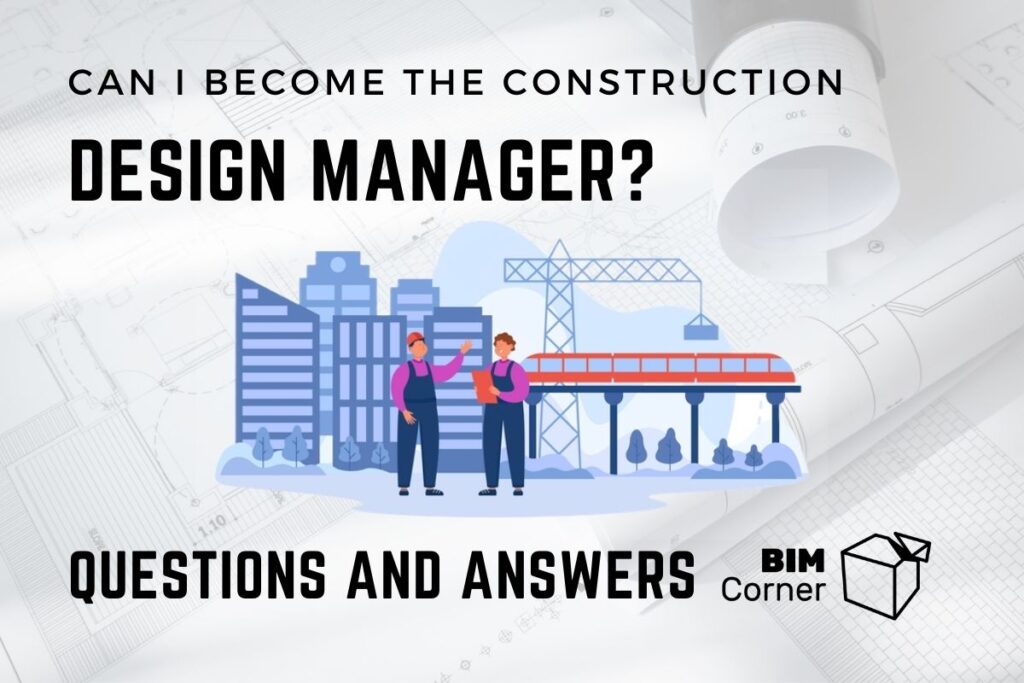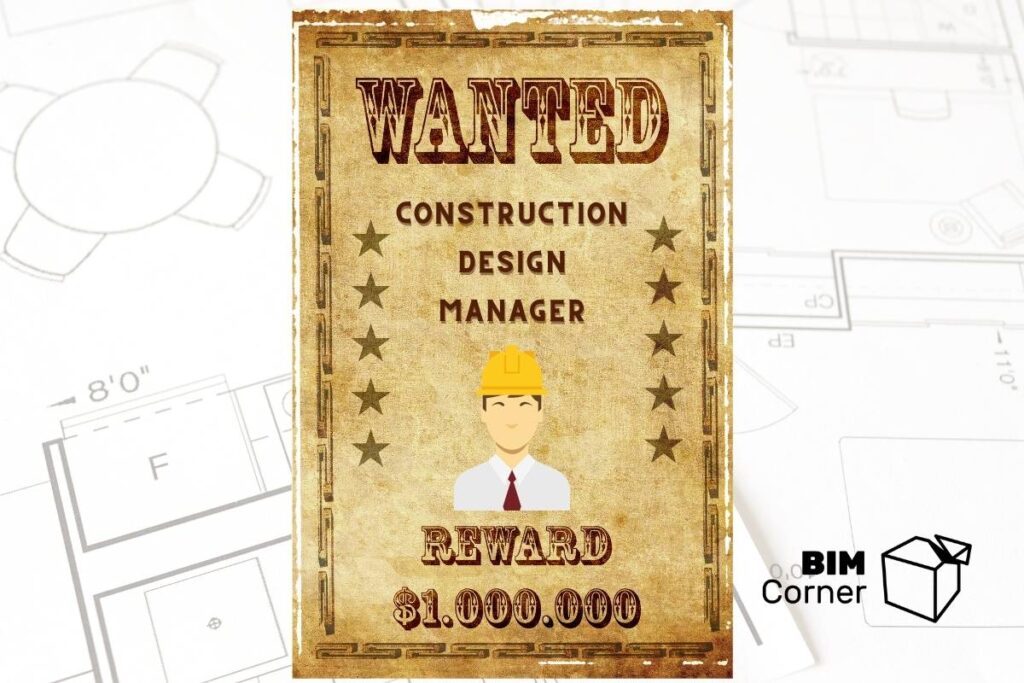You are soon graduating from a university. Or you are an experienced specialist, wanting to try something else. Or maybe your company has just started to look for a position of a construction design manager. In any case, most probably you have some questions like: is it for me? What kind of experience should I have? How much can I get? In this article, I am answering the most common questions regarding the position of the design manager in the construction industry.
The article is written in a way that there is a question in bold text first (like in the first one: Can I become a construction design manager?) and then an answer from me. Disclaimer: the answers are based on my own experience and knowledge and are my personal opinions on the topic. I invite you to read and comment with your own thoughts and experiences!
This is the fourth article in a series of construction design management. You can read the previous articles here:
- What is design management? Managing design in practice
- Different roles of the construction design manager
- BIM and the construction design management – tender
Did you like this post and should we continue the topic of design management? Or maybe there is some other topic that you would like to read about on our blog? Leave your opinion in the comment below the article!
Table of Contents
- Can I become a construction design manager?
- Why should I work as a design manager?
- How much experience should I have?
- What is a relevant experience? Or what kind of background is necessary to work as a design manager?
- Should I work as a Design Manager in an architect or design office, as an investor or a contractor?
- Why is the design manager’s position not so popular in my country?
- How much would I earn?
- What is the way forward in my career, after becoming a design manager?
- Should I know BIM?
Can I become a construction design manager?
Yes. Of course you can! However, it all depends on if you want to become the design manager. As you could read in our previous article Different roles of the construction design manager the DM (design manager) has a lot of responsibilities and should thrive in complex tasks.
Why should I work as a design manager?
If you already know that you would like to try yourself in this demanding role, I would say that there are many more reasons to do so. There are more and more design & build contracts on the market, and it doesn’t look like the trend is going to be reversed. And as I stated in the article What is design management? Managing design in practice:
‘The design management and a design manager are needed wherever the design process takes place.’ So be it an architect or design office, investor, contractor, or technical supplier, the design process is ongoing and somebody has to manage it.
How much experience should I have?
The correct question could be: how much relevant experience should you have for the position you are applying for? For example, if you would like to work as a junior design manager in a design office, on small- and middle-sized projects, 3-5 years of relevant experience from the construction industry could be enough. This assumes that you can work with another, more experienced DM from whom you can learn the trade. But if you would like to work on huge multi million projects in a contractor company, 5-8 years (even up to 10 years) of relevant experience could be a more correct assumption.
What is a relevant experience? Or what kind of background is necessary to work as a design manager?
A relevant experience is working on positions that can prepare you to work as a design manager. That could be a designer, BIM coordinator/manager, architect, site engineer, responsible for technical solutions and planning. It would be an advantage if you have some extra experience from not so obvious positions as a tender engineer or a surveyor. Generally, everything that helps you understand the entire project life cycle, including first concepts, tender, design and construction and facility management, would help you in the work as a design manager.
Should I work as a design manager in an architect or design office, as an investor or a contractor?
Depends on what interests you most! However, there can be some common characteristics of working in one of those project stakeholders. For example:
- Working as a DM and representing an architect or design office, you can go more into details and concentrate yourself on the design process.
- Working as an investor, you can define what the project should look like in the general and put requirements, and then follow up and control the work.
- Being the construction design manager from the contractor, you can influence the final product, but cannot go too much into details, since you should coordinate the general design process with the construction site and design office.
Why is the design manager’s position not so popular in my country?
It is a question that I have been asking myself, my colleagues, and people from other countries, a lot. It looks like the history and demand has a lot to say. I can show it on the examples from Poland and Norway.
In Poland, traditionally it is a lead architect and/or a lead designer who has a lot of responsibilities and (almost) everything should be decided or approved by him/her in person. In order to work as a lead architect/designer, you need to have a documented experience and pass demanding exams for state building qualifications. The system requires in a way that this one person takes the responsibility of managing the design.
In Norway, on the other hand, it is not necessary for a single person to have state building qualifications. It is a whole company who takes responsibility for design and/or construction. And since in Norway it is very popular to have people who are specialized in their discipline, a need for somebody who manages design emerged. Hence a role of a design manager (prosjekteringsleder) is on demand now, with most contracts being in the design & build formula.
Quick disclaimer: I am not judging which system is better or worse, just communicating the actual situation. I know also that both in the United Kingdom and in the USA, the position of the design manager is very popular. How is it in your country?
How much would I earn as the construction design manager?
This is probably the most interesting question and the most difficult to answer🙂 It all depends on your experience, role, country where you work in, organization, working hours and so on.
For instance, working in a construction company, you would probably earn around 8-10% more than working in a design office. But then again, you have a fixed contract, without overtime bonuses, and sometimes have to travel to the construction site.
As a DM from a designer or architect, you may earn less, but your overtime is paid. And you usually sit in an office, with less travelling as well. And as a DM in an investor/client organization, your work is (usually) more stable and defined, with paid overtime.
However, again, it all depends on many variables. From my observations, an experienced construction design manager could earn down to 10-20% less than an experienced project manager. Depending on the country and need for experts, this could also be the same salary for those two positions.
What is the way forward in my career, after becoming a design manager?
If you are just starting, you can become a junior, or assistant design manager. Then, with experience, you are a design manager, and after some time (depending on company), a senior design manager. From there you can become for example a technical director, or shift the position and start working as a project manager, BIM manager, or technical support in your company. Or if you like, you can just continue working as a design manager and become an expert in your field.
Should I know BIM?
Yes, definitely. Most importantly, you should know the practical use of BIM. No need to learn the whole ISO 19650 by heart;-) But you should know the advantages and different uses of BIM, its current limitations, utilization of CDEs, need for information at different stages, type of deliveries and so on. It is why an extra experience from work as a BIM coordinator or manager can be useful. Remember also that already now there has been executed some successful model-based projects (like Randselva bridge), and knowing the application of BIM in practice is crucial.
Summary of the construction design managements Q&A
There are always a lot of questions we ask ourselves while considering where we would like to work. We never truly know if a given position will suit us, until we try it and experience it. With this article and answers on the most popular topics, I hope that you have somehow a more clear picture on the different issues regarding work as a construction design manager.
If there are any more questions regarding the design management that you are asking yourself, please write to us at [email protected]! We are answering all the emails and appreciate your interest and involvement:-)
We are curious about your opinions and comments!
This is the fourth article in a series of construction design management. You can read the previous articles here:
- What is design management? Managing design in practice
- Different roles of the construction design manager
- BIM and the construction design management – tender
Did you like this post and should we continue the topic of design management? Or maybe there is some other topic that you would like to read about on our blog? Leave your opinion in the comment below the article!










Excellent article, thanks Konrad. Keep up the great work!
Thank you for the feedback Gregory! Is there anything more that you would like to read about on our blog?
Thanks a lot for the articles. I found the series really informative. I’m from Argentina and here, the rol as you defined it does not exist really. But, the duties you mentioned does exist of course. The thing is, the boundaries between BIM Managers, BIM Coorinators and BIM Modelers are still gray around here. Thanks again for sharing, and congrats for the nice work.
¡Hola Alvaro y gracias por tus comentarios! Who is then responsible for the duties of the design manager in Argentina? Is it a lead designer? Or a lead architect? Or is there another position, with similar duties?
Saludos desde Noruega:-)
Konrad